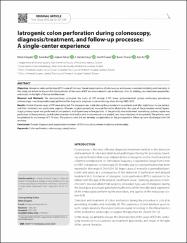Iatrogenic colon perforation during colonoscopy, diagnosis/treatment, and follow-up processes: A single-center experience
Erişim
info:eu-repo/semantics/openAccessTarih
2022Yazar
Gülaydin, Nihatİliaz, Raim
Özkan, Atakan
Gökçe, A. Hande
Önalan, Hanifi
Önalan, Berrin
Ari, Aziz
Üst veri
Tüm öğe kaydını gösterKünye
Gülaydın, N., İliaz, R., Özkan, A., Gökçe, A. H., Önalan, H., Önalan, B., & Ari, A. (2022). Functional and radiological comparison of three cephalomedullary nails with different designs used in the treatment of unstable intertrochanteric femur fractures of elderly. ULUSAL TRAVMA VE ACIL CERRAHI DERGISI-TURKISH JOURNAL OF TRAUMA & EMERGENCY SURGERY, 38(3), 221-229. https://doi.org/10.47717/turkjsurg.2022.5638Özet
Objective: latrogenic colon perforation (ICP) is one of the most feared complications of colonoscopy and causes unwanted morbidity and mortality. In this study, we aimed to discuss the characteristics of the cases of ICP we encountered in our endoscopy clinic, its etiology, our treatment approaches, and results in the light of the current literature.
Material and Methods: We retrospectively evaluated the cases of ICP among 9.709 lower gastrointestinal system endoscopy procedures (colonoscopy + rectosigmoidoscopy) performed for diagnostic purposes in our endoscopy clinic during 2002-2020.
Results: A total of seven cases of ICP were detected. The diagnosis was made during the procedure in six patients and after eight hours in one patient, and their treatment was performed urgently. Whereas surgical procedures were performed in all patients, the type of the procedure varied; laparoscopic primary repair was performed in two patients and laparotomy in five patients. In the patients who underwent laparotomy, primary repair was performed in three patients, partial colon resection and end-to-end anastomosis in one patient, and loop colostomy in one patient. The patients were hospitalized for an average of 7.14 days. The patients who did not develop complications in the postoperative follow-up were discharged with full recovery.
Conclusion: Prompt diagnosis and appropriate treatment of ICP is crucial to prevent morbidity and mortality.

















